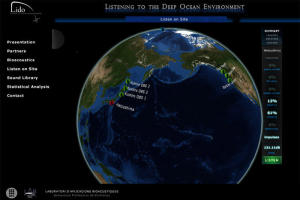
The Laboratory of Applied Bioacoustics (LAB), a unit of the Universitat Politècnica de Catalunya (UPC), directed by Professor Michel André, has recorded the sound of the earthquake that shook Japan on Friday, March 11. The recording, now available online, was provided by a network of underwater observatories belonging to the Japan Agency for Marine-Earth Science and Technology (JAMSTEC) and located on either side of the earthquake epicenter, close to the Japanese island of Hatsushima.
The UPC laboratory is using this platform as part of Listening to the Deep Ocean Environment (LIDO), a LAB-led international project. "LIDO aims, for the first time ever, to record deep-sea sounds in real time and determine how artificial sounds impact the conservation states of the marine environment," says Michel André. Equipped with hydrophones for monitoring underwater sounds in real-time over the Internet, the LIDO system has been continuously recording the sound of the earthquake and its aftershocks. LIDO obtains automatic recordings of the acoustic events detected. Sources are then identified and classified as being of biological or anthropogenic origin.
The system can be used to listen simultaneously to what is happening at different observatories. On March 11, 2011, at 2:45 p.m. Japanese local time, the LIDO system acoustically detected and recorded the earthquake at JAMSTEC observatories located off the coast off Kushiro and Hatsushima. The recording is available on the LIDO website http://listentothedeep.com. The sound of the earthquake and two aftershocks registered by these two Japanese observatories is available in the "Sound Library" section of the website (under "Earthquakes"). The data published there have been accelerated 16 times so that they can be audible to human ears. In the "Listen on Site" section of the same website, visitors can also listen to, and view, a live stream of the acoustic data in which aftershocks are continuously perceptible.
The spectrograms shown on the website reflect, both acoustically and visually, the intensity and energy distribution of the earthquake sound. The images illustrate the frequency and intensity of the sound by means of a spectrum of colors (with red and yellow being the most intense). The earthquake's effect on Japan's underwater ecosystem pales in comparison to its dramatic impact on the country's population. Nevertheless, due to their sensitivity to noise, cetaceans are considered valuable bioindicators of the natural acoustic balance of oceans.
Their sensitivity and their crucial role in ecosystems have already made it possible to determine the tolerance of the food chain to exposure to artificial sound sources. The LIDO system has given access to these exceptional geophysical data -- from Japan and other seismically active geographical areas around the world -- that are already being used in other disciplines as bioindicators of the natural balance of the oceans. They can now assist in the development of models that would integrate the reaction of cetaceans to noise as a geohazard indicator in the event of major seismic activity. The website also offers the general public the opportunity to witness the earthquake and follow its evolution in real time.
Undersea noise impact assessment
Understanding the link between natural and anthropogenic processes is essential to being able to predict the magnitude of the impact of changes in the natural balance of oceans. Deep-sea observatories can play a key role in assessing and monitoring these changes.
The LIDO project applies and extends techniques developed for passive acoustic monitoring to cabled deep-sea platforms and moored stations. Through the use of the information provided by existing and future underwater observatories, LIDO is helping to assess the impact of natural and human-made noise on the underwater environment and to describe long-term trends in ambient noise levels, especially as relates to the effects of human activities. The LIDO system contains several independent modules that process real-time acoustic data streams for noise assessment, detection, classification and localization of acoustic events, e.g. the presence of cetaceans.
The software developed under this project is currently in use at the European Sea-Floor Observatory Network (ESONET), at the ANTARES neutrino detector in France, at the UPC's OBSEA shallow-water test site off the coast of Vilanova i la Geltrú in Catalonia, at the underwater platforms of the University of Victoria's NEPTUNE network in Canada, and at the NEMO sites to the east of Sicily, operated by Italy's National Institute of Nuclear Physics.
The software is also being used at the JAMSTEC observatories off the coast of Kushiro and Hatsushima in Japan. The Kushiro platform is located 140 km from the city of the same name and 2,500 m below sea level, while the Hatsushima platform is located 1,174 m beneath the sea in Sagami Bay. The epicenter of the March 11 earthquake is located between these two observatory networks. JAMSTEC's objective is to predict and understand global change phenomena triggered by large-scale natural disasters and environmental destruction caused by global warming, continental and submarine earthquakes, and volcanic eruptions.
Under an ongoing scientific collaboration agreement between the UPC, Japan's National Research Institute of Fisheries Engineering (Fishing Technology and Information Science Division) and JAMSTEC, LIDO is continuously analyzing a live acoustic stream from the sea off the east coast of Japan in order to understand the effect of noise sources on marine fauna and ecosystems, as well as on the movement patterns of great whales.
Source:
sciencedaily


 Previous page
Previous page Back to top
Back to top







